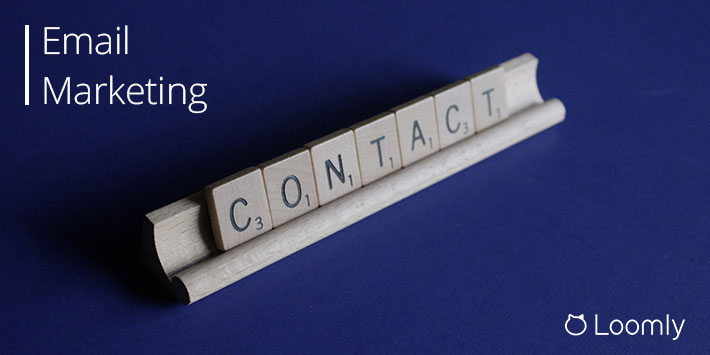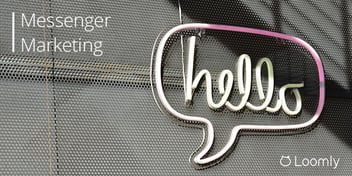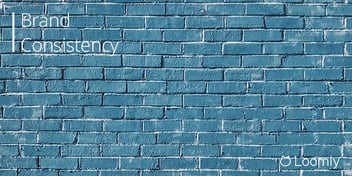With the abundance of communication apps and mobile messengers hitting the market, it‘s easy to forget plain old email marketing.
But instead of declining, email keeps on growing year on year.
Latest figures from Statista predict the number of emails sent and received each day will continue to rise from 293.6 billion in 2019 to 361.6 billion by 2024. And when you add in that the average ROI for email campaigns is around 4,200%, it’s hard to ignore the fact email is a powerful and cost-effective marketing channel.
In this guide, you’ll discover what email marketing is and why it matters to your brand before checking out seven examples of successful campaigns. Finally, we’ll show you the five steps you need to follow to design and implement a winning email marketing strategy for your brand.
Let’s get started!
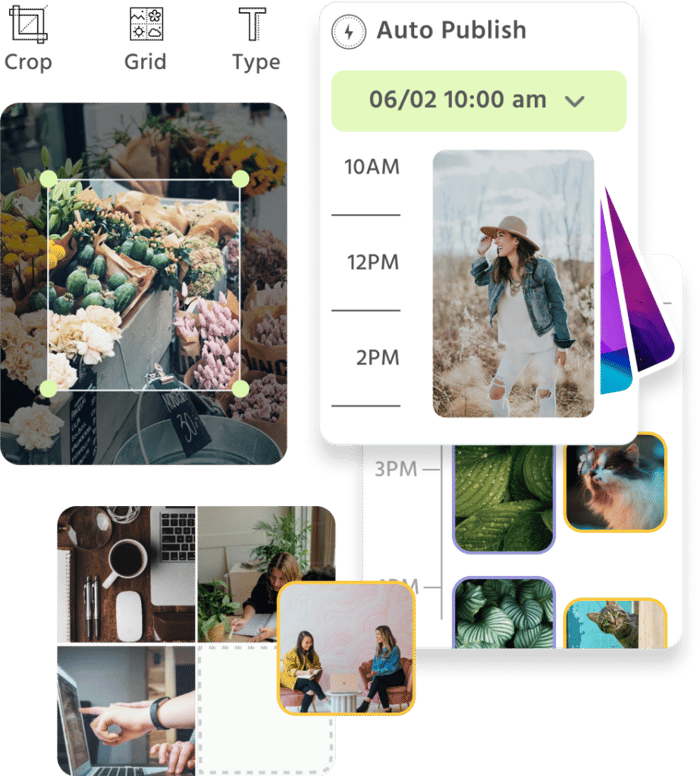
Manage all your social media accounts in one place.
Craft, schedule, & auto-post content to all your social channels, then track analytics and manage interactions from a single, easy-to-use dashboard.
What is Email Marketing?
Email marketing is a powerful digital marketing channel that’s used to send various types of content to a list of subscribers via email. You can use email marketing to generate leads, promote brand awareness, convert prospects into customers, and turn customers into loyal fans.
[Note: Subscribers must opt-in and give permission to receive such emails.]
Marketing emails vs transactional emails
There are two types of email marketing that you can use:
- Marketing emails
- Transactional emails
Marketing emails, also referred to as commercial emails, are sent strategically at pre-configured times to a list of prospects or customers. They contain marketing and promotional content aimed at getting the recipients to take further action.
For example, Spotify sent this promotional upsell email offering a 3-month free trial of their Premium service:
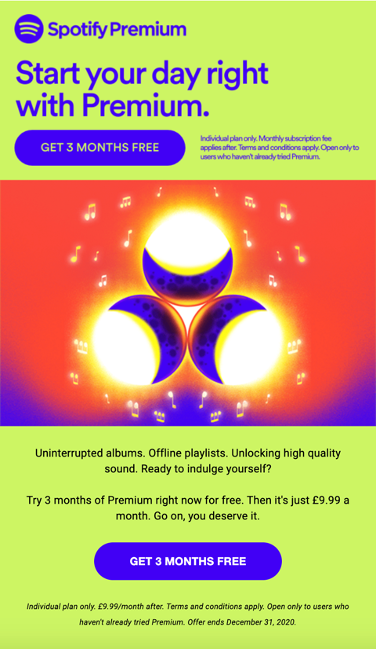
Other examples of marketing emails include:
- Newsletters
- Marketing campaigns
- Welcome email series
- Discount coupons
- Cross-sells
- Upgrades
Transactional emails contain information that’s unique to each recipient and are used frequently in ecommerce marketing. They’re usually triggered by user actions and prompt individuals to complete a transaction or process.
For example, when a user accepts the Spotify Premium promotional offer, they receive an order confirmation receipt email:
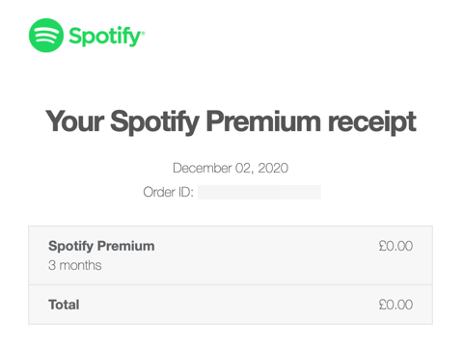
Plus a warm welcome email:

Other examples of transactional emails include:
- Abandoned shopping cart
- Discounts on recently browsed products
- Shipping confirmation
- Feedback requests
- Event reminders
- Password resets
Email marketing automation
Whether you’re sending transactional or marketing emails, you can use email marketing automation to send the emails to your contacts based on a pre-defined trigger or event. For example, when a new user subscribes to your email list, you can automatically send a welcome email:
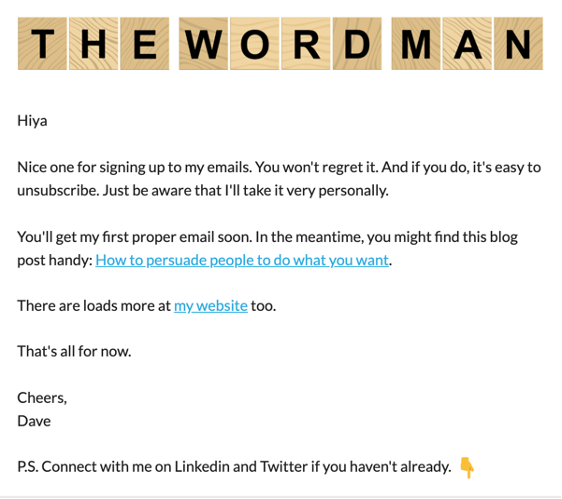
There are two types of email automation:
- Time-based
- Behavior-based
Time-based automation delivers emails on a specific date and time or at a pre-configured interval in a series. For example, you could have a “Welcome Series” of seven emails scheduled to be sent daily for seven days after a new subscriber joins your list.
Behavior-based automation is a smarter type of automation that lets you personalize what and when you deliver your emails. For instance, you could monitor your Welcome Series to see if a user clicks on a particular link. Based on that behavior, you could send an additional email (outside of the standard welcome series) informing them of a special offer.
Both forms of email marketing automation allow you to send timely, relevant, personalized, and contextual messages that increase brand loyalty and drive customer engagement.
Why Email Marketing Matters to Your Brand
Email marketing continues to out-perform other digital marketing channels, regardless of which metric you measure.
Let’s examine some stats about email usage, open rates, and ROI:
Email usage
The number of emails sent and received each day has been rising year on year. In 2019, around 293.6 billion emails were sent and received worldwide every day. That figure is expected to increase to over 361.6 billion daily emails by 2024:
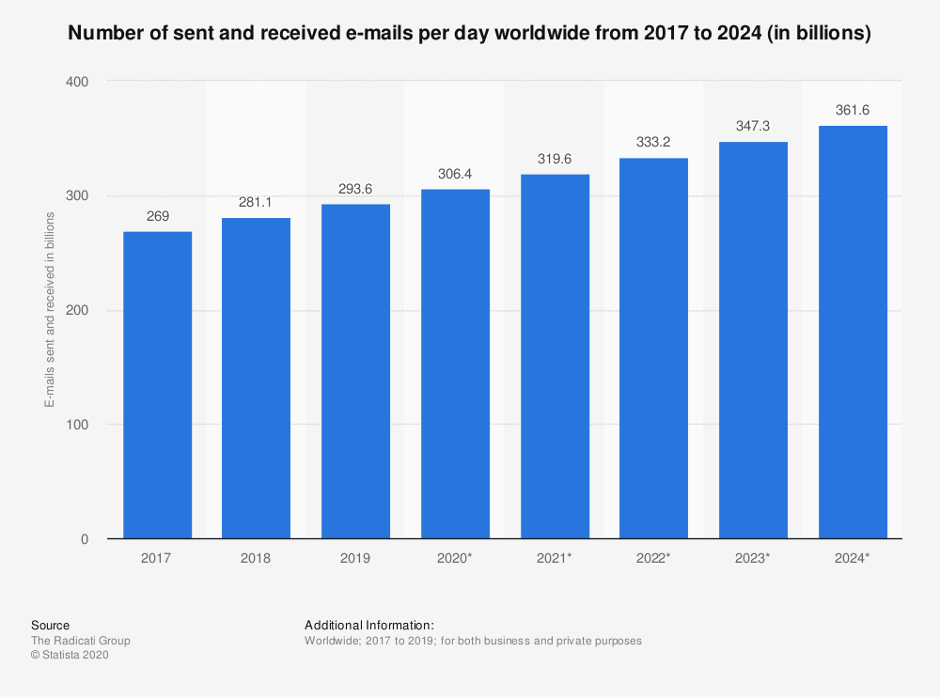
Despite the growth and prominence of social media, mobile messengers, and chat apps, over half of the global population (7.8 billion) uses email. In 2019, the number of global email users totaled 3.9 billion — a figure predicted to reach 4.48 billion by 2024:
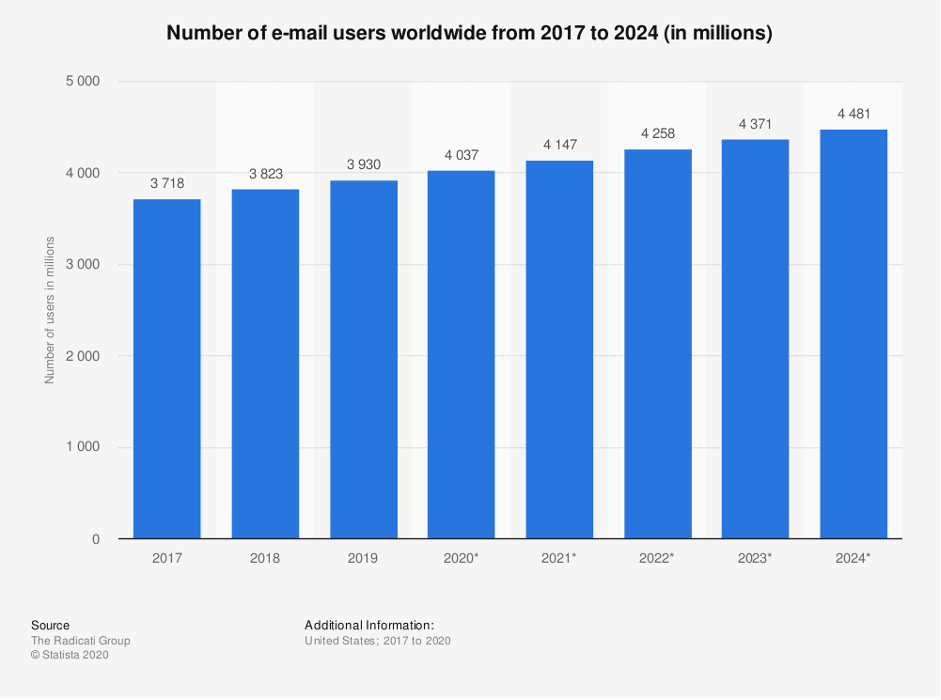
Email open rates
Campaign Monitor’s research of 30+ billion emails (sent globally between January and December 2019) found the average email open rate was 17.8%. The top-performing industries achieved a higher figure:
- Government (30.5%)
- Nonprofit (25.2%)
- Education (23.4%)
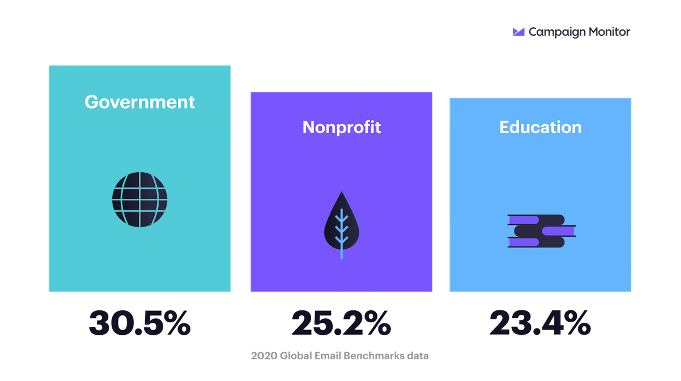
In 2018, Mailchimp discovered the most opened emails related to hobbies, with an open rate of 27.35%.
While data from GetResponse showed that welcome emails have the highest open rates. On average, 82% of welcome emails get opened because customers expect them to land in their inbox.
Testing by Campaign Monitor found that personalized email subject lines increase open rates by 26%.
And finally, according to Experian, open rates for transactional emails are four to eight times higher than regular marketing emails because customers usually ask for the information contained in them.
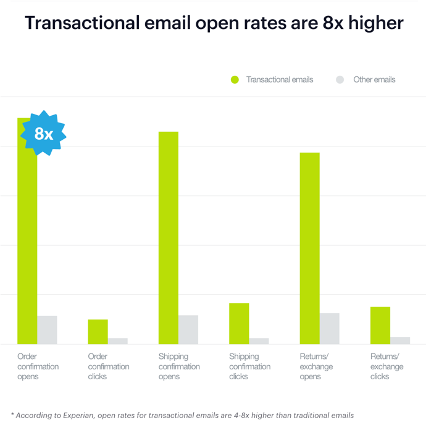
Email marketing ROI
According to the DMA research (2019), for every $1 you spend on email marketing, you can expect an average return of $42. That’s a rise of almost $10 since the previous study and a whopping 4,200% ROI, making it one of the most effective marketing channels available:
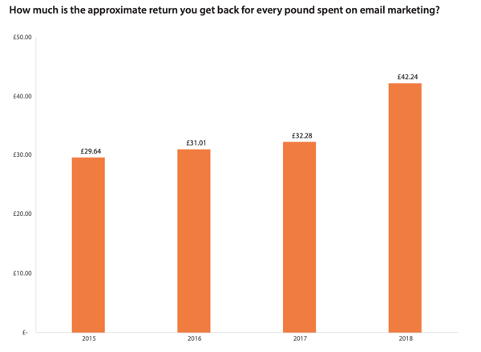
According to 2018 research by email marketing service Emma, 59% of marketers say email generates their highest ROI. And 66.3% of participants in a marketing survey by Litmus expect email ROI will increase in 2020.
7 reasons why your brand should use email marketing
Here are seven more compelling reasons why your brand needs to use email marketing:
1. Email has a more extensive reach
With over half of the global population using email, it’s by far the most popular means of communication. In contrast, Facebook – the most popular social network – has 2.603 billion active users.
2. Email delivers your message
Given the choice of getting either a new email subscriber or a new Facebook follower, which would you choose?
Research suggests an email subscriber is more valuable. An impressive 90% of email gets delivered to the intended recipient’s inbox, whereas only 2% of your Facebook fans are likely to see your posts in their News Feed (source: Ogilvy).
3. Email drives conversions
The ultimate goal for marketers is to turn prospects into customers. And when it comes to conversions, there isn’t a more powerful channel than email.
Figures show that the average click-through rate of an email campaign is around 3% of total recipients, whereas the average click-through rate from a tweet is about 0.5%.
4. Email has a higher ROI
As highlighted above, email has the highest ROI compared to other marketing channels. Email marketing lets you send personalized and relevant messages while other channels are less direct.
5. Email is the preferred communication channel
Studies by Marketing Sherpa shows that 72% of people prefer to receive promotional content through email, compared to 17% who prefer social media. Furthermore, according to Statista, 49% of consumers said they would like to receive promotional emails from their favorite brands every week.
6. Email is an open communication platform
Email isn’t owned or controlled by a particular third-party — there are loads of services that provide access to send and receive emails.
Compared to other marketing channels like social media and organic search, you can invest time and money into building and cultivating an email list that you own and control.
7. Email will be around forever
The first email marketing campaign was sent in 1978 to a total of 400 people. But even with all the latest technological developments, it continues to grow in popularity and shows no signs of slowing down.
Building your email list is a robust long-term investment that will pay off for many years to come.
Examples of Successful Email Marketing Campaigns
Let’s take a look at some of the different types of email marketing campaigns you could use.
Loomly – Weekly Newsletter
The newsletter is probably the best-known type of marketing email. It’s typically sent on a daily, weekly, fortnightly, or monthly basis, so readers come to expect it in their inbox at a regular time.
Loomly’s Brand Success Digest is a weekly newsletter that follows a regular format and contains three items of news:
- Loomly product feature – the latest product update
- Hot On The Loomly Blog – the latest blog article
- Read of the week – a related blog article from elsewhere
The format keeps Loomly users up to date with the latest product developments as well as serving marketing content to help them maximize their investment.

FreeAgent – Product Update
Retaining customers and turning them into loyal fans is an often overlooked marketing strategy. So one email marketing campaign you can use is to impress existing customers by adding more product functionality.
That’s what accounting software FreeAgent did with their new Cashflow feature. The copy for this new functionality is on point as it compares the unforeseen events of the coronavirus pandemic with not knowing how your cashflow is looking.
“2020: it’s been wild. Not even Mystic Meg could have known what would happen this year, and I’m sure we’re all looking forward to a (hopefully) more stable and predictable 2021.
To kick the new year off with a bang, we’ve just launched some brand new cashflow functionality. The new feature automatically builds your near-term cashflow forecast based on the data you already have in FreeAgent, including invoices, bills, salary, and upcoming tax liabilities.”
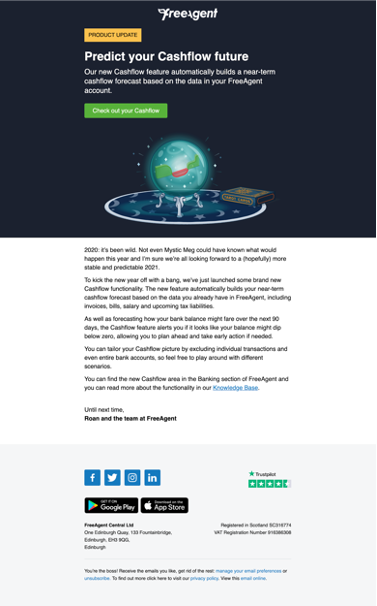
TechSmith – Free Upgrade
Keeping existing customers sweet with a free upgrade is another fine example of email marketing.
In this example, TechSmith announces the latest version of their product – SnagIt 2021 – and then reinforces the benefits of their maintenance agreement — i.e. you get the upgrade for free.
“As one of the many benefits of your current Snagit Maintenance Agreement, you are eligible for a free upgrade to the new Snagit 2021!”
But that’s not all. Further down the email, they also highlight another benefit – free training and certification – before finishing with some new product features:

Microsoft 365 – Subscription Renewal
Subscription renewals get triggered automatically by anniversaries. Brands can use them to thank existing customers for using their product or service, highlight any news, and advise them to take action or let things renew automatically.
Here’s how Microsoft pitched a change in product name along with an auto-renewal message:
“Office 365 becomes Microsoft 365 automatically on 21 April 2020, and you don’t have to do a thing. Best of all, the price stays the same.”
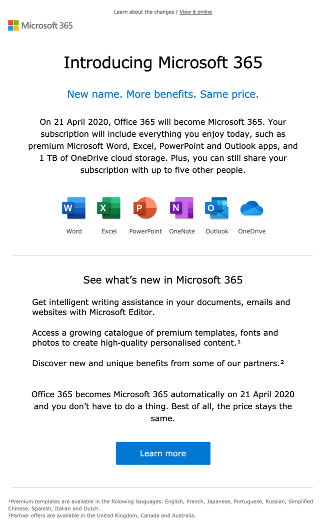
Grammarly – User Re-engagement
Re-engagement emails let you target inactive contacts or customers automatically based on conditions such as the length of time since their last website visit or product click.
Brands often use the opportunity to entice users back with an exclusive offer or coupon to get them excited about using their product or service again.
For example, Grammarly awards badges to their users based on how much they’ve used the product. So it’s no surprise that it should award inactive users with “The Wrinkle in Time Badge”, followed by a big “GO!” button to start using the product again, along with a special offer for their premium product:
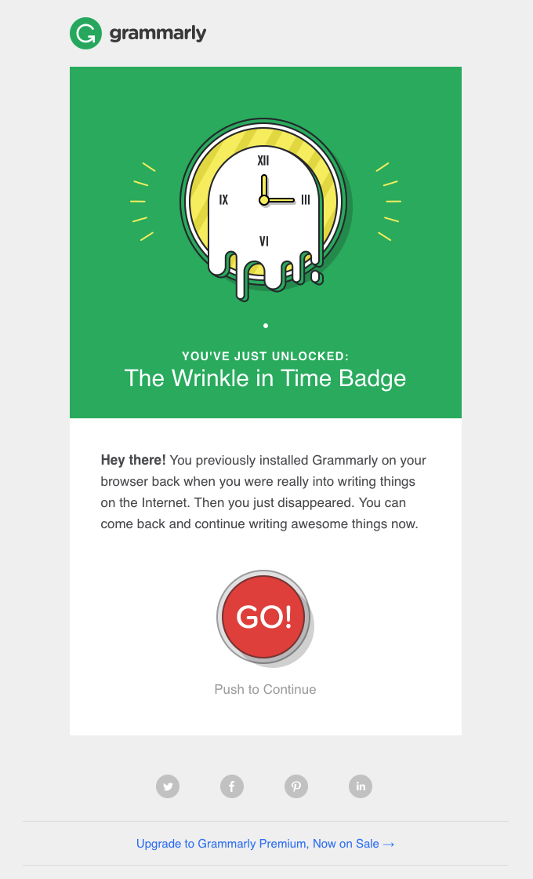
Dyson – Abandoned Shopping Cart
Fact: 69% of shoppers abandon their carts before checking out. So sending an abandoned shopping cart email is a great way to nudge shoppers to buy your product.
Dyson does this really well by showing an image of the product and the item in the customer’s cart. Plus, they added some urgency by reminding the recipient that this promotion is for a limited time only.
“Your basket for this promotion was saved, but the offer is only for a limited time.”
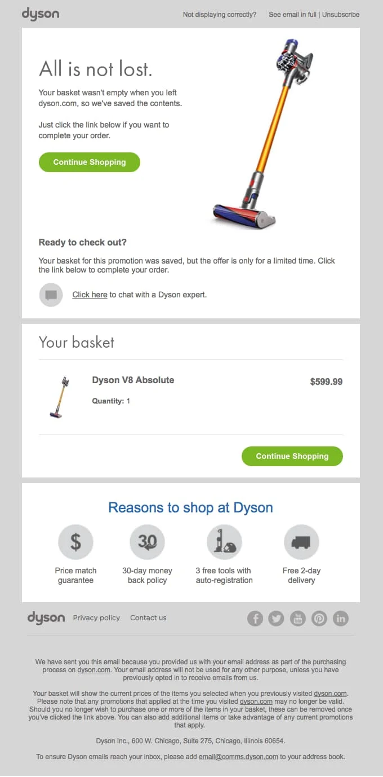
Image source: Really Good Emails
How to Design and Implement a Winning Email Marketing Strategy for Your Brand
In this section, you’ll discover the five steps to design and implement a winning email marketing strategy:
- Identify your goals
- Build your email list
- Select which email campaign type to use
- Create your first email marketing campaign
- Measure your email campaign performance
Let’s dive in!
Step 1: Identify your goals
Before you start creating and sending emails, you need to identify your email marketing goals and make sure they align with your overall business goals.
For example:
- Business goal – generate revenue through the sale of your product.
- Marketing goal – increase leads and sales.
- Email marketing goal – promote product features to drive new signups for your product.
As you’ve seen in the examples above, you can use email marketing to achieve different objectives.
Your goals will dictate the type of campaigns you send, who you target, the content you include, and how you measure success.
Step 2: Build your email list
Now you’ve identified your goals, it’s time to start building your email list.
Option 1: Use existing contacts
If your goal is to keep in touch with existing customers and you already have a list of contacts in another database, such as your CRM or ecommerce software, then you could import those contacts into your email marketing tool.
The only caveat is that you need the permission of those contacts to email them.
Option 2: Start from scratch
If your goal is to attract new leads, then you’ll have to capture their email addresses to build a new list of subscribers.
The most common way that brands do this is by offering an incentive (sometimes called a lead magnet) such as a free guide or a free trial of the product, to entice people to subscribe to the list,
The other consideration is where and how you’re going to present your opt-in form.
Let’s take a look at a couple of examples:
1. Beardbrand
Beardbrand’s incentive to subscribers is to:
“Sign up to our newsletter to receive grooming tips, style inspiration, exclusive access to pre-launch product pricing, and more.”
That offer ties in with their mission to “make men awesome … through amazing content and class-leading products.”
This example is placed in the middle of their homepage:
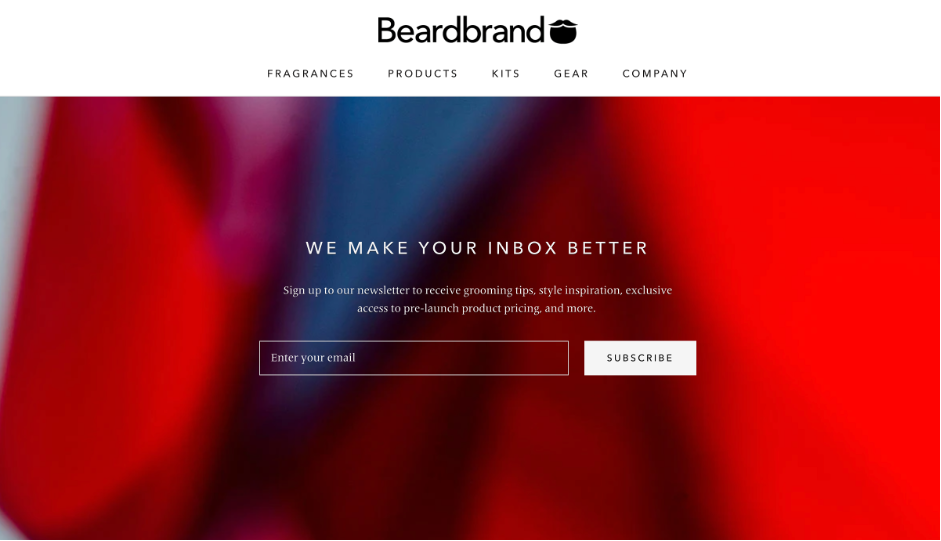
But there are other signup boxes in different shapes and sizes placed around the site, like this simple form in the footer:
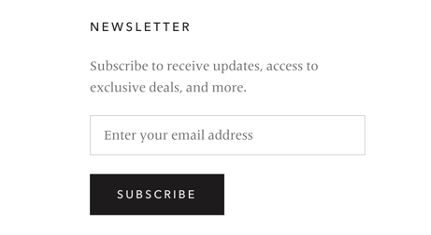
2. Front
Communication platform Front offers a 7-day free trial of their app in exchange for an email address. Their goal is to get product signups, so this type of incentive is common for software vendors:
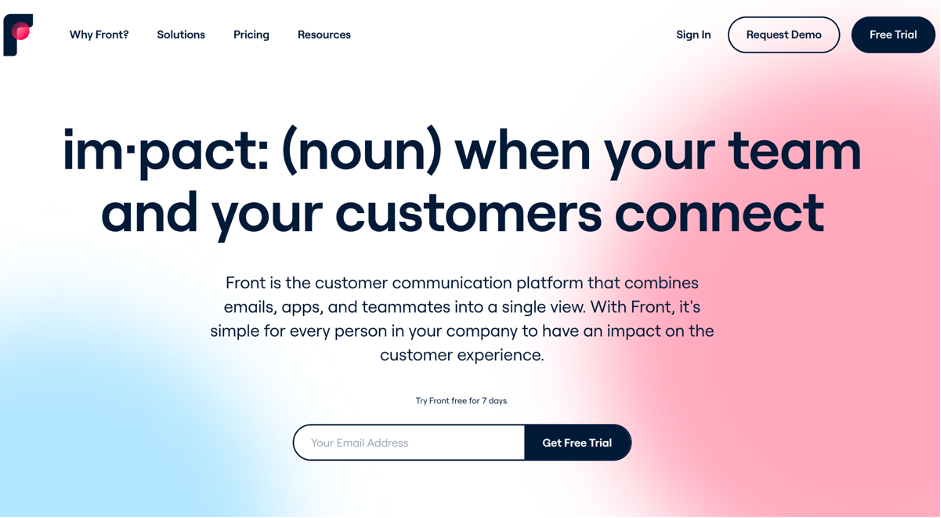
As well as the main opt-in box on the homepage, notice the Free Trial button in the top right corner of the menu.
Step 3: Select your email campaign type
There are various types of email marketing campaigns you can send, as you saw in the examples above. Your choice of email campaign will depend on the goals you identified in Step 1.
Here’s a quick reminder of four types of email marketing campaign you could use:
1) A newsletter is a regular email campaign that covers one or more topics.
Example: The Jam Sandwich
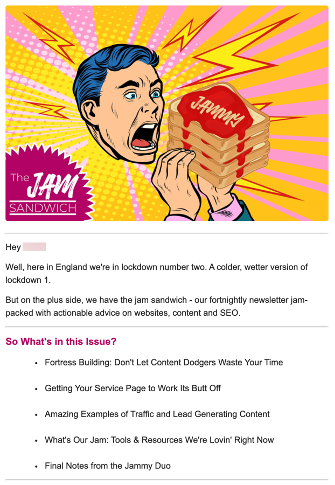
2) A promotional offer campaign is any email you send to drive a direct response.
Example: Affinity Black Friday sale
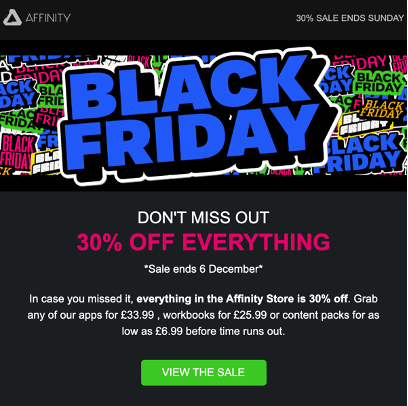
3) An announcement campaign is an email sent to your subscribers announcing a new product, feature, or service.
Example: Apple announces MacOS Big Sur
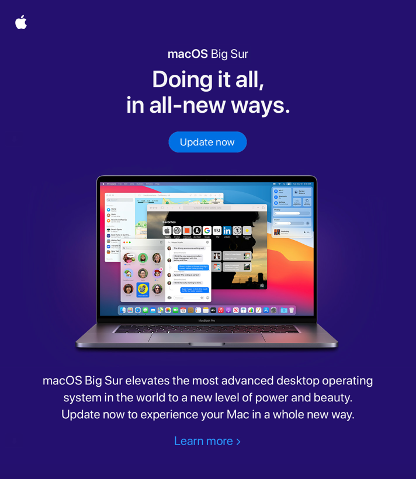
4) An event campaign is an email invitation designed to increase awareness of your event and encourage people to attend.
Example: SEMrush’s invitation to attend their webinar on the Digital Marketing Trends for 2021
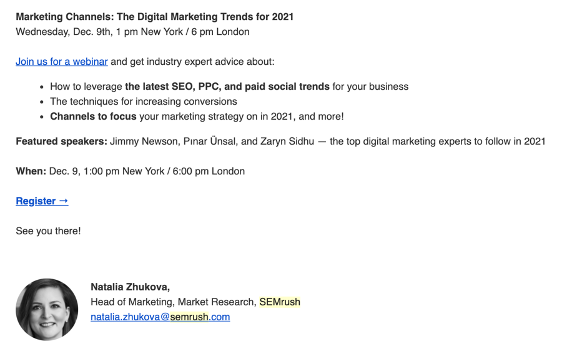
Step 4: Create your email marketing campaign
Now that you’ve identified your goals, started building your list of subscribers, and selected the type of email marketing campaign you’re going to send, it’s time to start creating your email.
Most email marketing tools have similar features, so it’s just a case of following some basic guidelines.
1. Make your content easy to read
Different campaigns have different layouts and formats. For example, newsletters tend to be more like a magazine, whereas an announcement might be more text-only. The point is, whatever your campaign, make sure the content is easy to read on desktop and mobile.
2. Avoid walls of text
Even if your email content is text-only, you can still format the text with bold fonts, bullet lists, and subheaders to make it easier to scan and read.
3. Segment your subscribers
Consumers want to receive relevant, targeted content. As you build your list, you can segment your subscribers into different categories, such as location, demographics, market, interests, and previous activity.
Research by the DMA found that 24% of email campaigns are neither segmented nor automated:
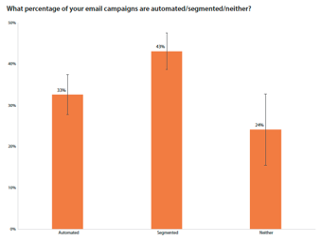
Whereas research by Campaign Monitor found that marketers who used segmented campaigns noted as much as a 76% increase in revenue:
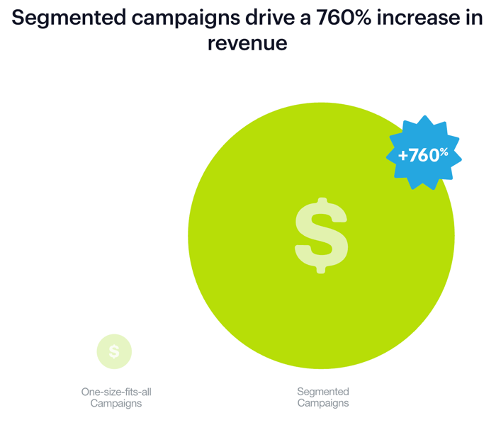
4. Personalize your content
As well as sending relevant content, make sure you personalize it, too. As long as you collect a subscriber’s name with their email address, you can personalize subject lines, greetings, and the email message.
According to data from GetResponse, personalization in the email body increased the click-through, click-to-open, and open rates.
5. Keep your campaigns on brand
Make sure your email campaigns align with the colors, fonts, and branding you use across all your other marketing channels so that your customers have a consistent experience with your brand.
6. Make it easy to convert
Whatever your goal is, you’ll want recipients to take action on your email message. Whether that’s to upgrade or attend your event, make it easy for them to click or tap your CTA.
7. Plan and schedule your campaigns
Just like any other marketing campaign, it’s essential to plan your campaigns with an editorial calendar. It’s critical to get the timing and frequency right so that you don’t overwhelm or lose the attention of your subscribers.
Plus, you’ll also want to get the balance of your content right.
Remember the Beardbrand example from earlier? They don’t send email after email about buying their products. Instead, they mix things up with content on grooming tips and inspiring beard style.
Bottom line: Whatever email you send, make sure it’s relevant and timely.
Step 5: Measure your performance
After you’ve sent your email marketing campaign, you can start tracking performance in a couple of places:
- Your email marketing tool.
- Your website analytics tool, such as Google Analytics.
Most email marketing tools will give you a high-level overview and include metrics like:
- Number of unique opens – The number of unique subscribers who opened your campaign.
- Number of bounces – The number of email addresses to which your campaign could not be delivered.
- Number of emails not opened – The number of subscribers who did not open your campaign.
- Open rate – The percentage of all subscribers who opened your campaign.
- Click-through rate – The percentage of people who opened your campaign and then clicked on a link.
- Unsubscribe rate – The percentage of people who unsubscribed from your email list through this campaign.
If you integrate your email marketing tool with Google Analytics, then you’ll be able to track details of any website visits from your email campaigns, including how long they spent on your site, what pages they visited, the number of conversions (e.g. product signups), and more.
Each campaign will have its own goal, so measure your success against those goals and metrics to evaluate what worked and what needs adjusting in the next campaign.
Areas you can adjust and split-test include subject lines, body copy, CTA buttons, timing, and segmentation. Test one thing at a time so you can qualify the results.
Email Marketing in a Nutshell
Email marketing is a powerful digital marketing channel used to send various types of transactional and promotional content to a list of subscribers via email. You can harness the power of different email marketing campaigns to promote brand awareness, generate leads, convert prospects into customers, and turn customers into loyal fans.
Design and implement a winning email marketing strategy for your brand by following these five steps:
- Identify your business and marketing goals.
- Build your email list.
- Select your email campaign type.
- Create your email marketing campaign.
- Measure your performance and adjust accordingly.
